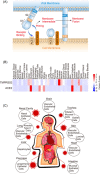Comprehensive role of SARS-CoV-2 spike glycoprotein in regulating host signaling pathway
- PMID: 35488404
- PMCID: PMC9348444
- DOI: 10.1002/jmv.27820
Comprehensive role of SARS-CoV-2 spike glycoprotein in regulating host signaling pathway
Abstract
Since the outbreak of coronavirus disease 2019 (COVID-19) caused by severe acute respiratory syndrome coronavirus 2 (SARS-CoV-2) infection, global public health and the economy have suffered unprecedented damage. Based on the increasing related literature, the characteristics and pathogenic mechanisms of the virus, and epidemiological and clinical features of the disease are being rapidly discovered. The spike glycoprotein (S protein), as a key antigen of SARS-CoV-2 for developing vaccines, antibodies, and drug targets, has been shown to play an important role in viral entry, tissue tropism, and pathogenesis. In this review, we summarize the molecular mechanisms of interaction between S protein and host factors, especially receptor-mediated viral modulation of host signaling pathways, and highlight the progression of potential therapeutic targets, prophylactic and therapeutic agents for prevention and treatment of SARS-CoV-2 infection.
Keywords: ACE2 receptor; S protein; SARS-CoV-2; signaling pathway.
© 2022 Wiley Periodicals LLC.
Conflict of interest statement
The authors declare no conflicts of interest.
Figures




Similar articles
-
The expression of hACE2 receptor protein and its involvement in SARS-CoV-2 entry, pathogenesis, and its application as potential therapeutic target.Tumour Biol. 2021;43(1):177-196. doi: 10.3233/TUB-200084. Tumour Biol. 2021. PMID: 34420993 Review.
-
Potential therapeutic approaches for the early entry of SARS-CoV-2 by interrupting the interaction between the spike protein on SARS-CoV-2 and angiotensin-converting enzyme 2 (ACE2).Biochem Pharmacol. 2021 Oct;192:114724. doi: 10.1016/j.bcp.2021.114724. Epub 2021 Aug 8. Biochem Pharmacol. 2021. PMID: 34371003 Free PMC article. Review.
-
Angiotensin-Converting Enzyme 2 (ACE2) in the Pathogenesis of ARDS in COVID-19.Front Immunol. 2021 Dec 22;12:732690. doi: 10.3389/fimmu.2021.732690. eCollection 2021. Front Immunol. 2021. PMID: 35003058 Free PMC article. Review.
-
Optimized Pseudotyping Conditions for the SARS-COV-2 Spike Glycoprotein.J Virol. 2020 Oct 14;94(21):e01062-20. doi: 10.1128/JVI.01062-20. Print 2020 Oct 14. J Virol. 2020. PMID: 32788194 Free PMC article.
-
Coevolution, Dynamics and Allostery Conspire in Shaping Cooperative Binding and Signal Transmission of the SARS-CoV-2 Spike Protein with Human Angiotensin-Converting Enzyme 2.Int J Mol Sci. 2020 Nov 4;21(21):8268. doi: 10.3390/ijms21218268. Int J Mol Sci. 2020. PMID: 33158276 Free PMC article.
Cited by
-
Allosteric Signal within the Receptor-Binding Domain of the SARS-CoV-2 Spike Protein Mediated by a Class 3 Monoclonal Antibody Revealed through Molecular Dynamics Simulations and Protein Residue Networks.ACS Omega. 2024 Jan 18;9(4):4684-4694. doi: 10.1021/acsomega.3c07947. eCollection 2024 Jan 30. ACS Omega. 2024. PMID: 38313482 Free PMC article.
-
Interactions of SARS-CoV-2 with Human Target Cells-A Metabolic View.Int J Mol Sci. 2024 Sep 16;25(18):9977. doi: 10.3390/ijms25189977. Int J Mol Sci. 2024. PMID: 39337465 Free PMC article. Review.
-
Decoding the intricacies: a comprehensive analysis of microRNAs in the pathogenesis, diagnosis, prognosis and therapeutic strategies for COVID-19.Front Med (Lausanne). 2024 Oct 7;11:1430974. doi: 10.3389/fmed.2024.1430974. eCollection 2024. Front Med (Lausanne). 2024. PMID: 39434774 Free PMC article. Review.
-
Semi-Covariance Coefficient Analysis of Spike Proteins from SARS-CoV-2 and Its Variants Omicron, BA.5, EG.5, and JN.1 for Viral Infectivity, Virulence and Immune Escape.Viruses. 2024 Jul 25;16(8):1192. doi: 10.3390/v16081192. Viruses. 2024. PMID: 39205166 Free PMC article.
-
SUMOylation of SARS-CoV-2 spike protein is a key target for broad-spectrum antiviral therapy.Theranostics. 2025 May 25;15(13):6369-6386. doi: 10.7150/thno.111256. eCollection 2025. Theranostics. 2025. PMID: 40521184 Free PMC article.
References
Publication types
MeSH terms
Substances
LinkOut - more resources
Full Text Sources
Medical
Miscellaneous

